
Based on M&M's nutrition facts, if you have enough discipline to eat only one candy, you won't be filling up on too many calories. But if you consume the whole bag or even indulge in different versions like peanut or pretzel M&M's, the calories will add up.
Tip
As per the USDA's M&M's nutrition facts, a single candy contains 3.4 calories, while one package provides 236 calories, 2 grams of protein and more than 30 grams of sugar. M&M's peanut chocolate candies, on the other hand, supply 10.3 calories per piece and 242 calories, 4.5 grams of protein and about 24 grams of sugar per package.
Video of the Day
M&M's Nutrition Facts
M&M's are a favorite candy among children and grownups alike. Eating them in moderation won't have a big effect on your health. But most people rarely stick to a single serving, which may lead to weight gain and other issues in the long run.
Video of the Day
These candies are loaded with sugar, additives and chemicals. According to the USDA, M&M's contain the artificial dyes Blue 1, Blue 2, Yellow 5, Yellow 6 and Red 40.
A May 2013 study published in the Journal of General Physiology states that food dyes, especially Blue 1, should be given serious consideration for their effects on the nervous system and health conditions like Crohn's disease and stroke. As the Center for Science in the Public Interest notes, there have been health concerns surrounding the link between artificial dyes and children's behavior.
According to the Environmental Working Group's milk chocolate M&M's nutrition facts, these candies are 64 percent sugar by weight and contain 5 teaspoons of added and natural sugar per serving. On top of synthetic food dyes, they also boast high levels of saturated fat and fat-free milk derived from animals that were possibly treated with antibiotics and artificial growth promoters.
Read more: The 20 Most Dangerous Candies
The Dangers of Sugar
The Centers for Disease Control and Prevention (CDC) states that added sugars are sugars added to foods or beverages when they are processed or prepared. They are different from the sugars found in fruit or milk, which are naturally occurring.
As reported by the 2015-2020 Dietary Guidelines for Americans, you should keep your intake of added sugars to less than 10 percent of your total daily calories as part of a healthy diet. Brown sugar, corn sweetener, corn syrup, fructose, glucose and dextrose are all examples of added sugars.
According to a January 2017 study published in Translational Medicine @ UniSa, high-sugar diets may increase the risk of chronic diseases, including obesity, cardiovascular disease, diabetes, non-alcoholic fatty liver disease and some types of cancers. As the scientists point out, it's important to reduce the number of calories in your diet, as well as the amount of added sugars, to enjoy good health.
Read more: 15 Reasons to Kick Sugar
Alternative Options to Chocolate
Chocolate is one of the most beloved foods in the United States. The problem is that it's loaded with sugar and empty calories.
According to the Harvard T.H. Chan School of Public Health, chocolate in its natural state (cacao) may benefit your heart and overall health. Rich in antioxidants, it may help lower blood pressure, reduce inflammation and protect against cardiovascular disease.
Unfortunately, when cacao is processed into candies like M&M's, it loses all of its health benefits. Therefore, it is best to find alternatives to sugary treats like milk chocolate and candies. The following options will satisfy your sweet tooth without sabotaging your diet:
- Cocoa powder is a mixture of substances derived from cocoa beans after cocoa butter is extracted. One tablespoon has only 12 calories and little to no fat, cholesterol or sugar — plus, it's packed with antioxidants. Try mixing cocoa powder into almond milk for hot chocolate or into plain Greek yogurt for a healthy dessert.
- Cacao nibs are essentially the cocoa beans themselves after being extracted from their husks and broken into little pieces. They come in roasted or raw varieties, are crunchy and have a similar taste to unsweetened chocolate. You can mix cocoa nibs into yogurt or trail mixes for extra flavor.
- Dark chocolate can be part of a healthy diet as long as it's the right type (at least 70 percent cacao) and the right portion size (about 1 ounce). The darker the chocolate, the higher the percentage of cocoa and the less sugar in the bar.
- Fruits are a great option to satisfy your sugar cravings. They're high in vitamin C, potassium, antioxidants and fiber, making it easier to boost your nutrient intake.
- Environmental Working Group: "M&M's Chocolate Candies, Milk Chocolate"
- USDA: "M&M's Milk Chocolate Candies (Formerly M&M's Plain Chocolate Candies)"
- Health.gov: "Dietary Guidelines for Americans, 2015-2020: Chapter 2. Food Category Sources of Added Sugars in the U.S. Population Ages 2 Years and Older"
- Centers for Disease Control and Prevention: "Know Your Limit for Added Sugars"
- Harvard T.H. Chan School of Public Health: "Dark Chocolate"
- U.S. National Library of Medicine: "Potassium"
- Journal of General Physiology: "The Food Dye FD&C Blue No. 1 Is a Selective Inhibitor of the ATP Release Channel Panx1"
- Center for Science in the Public Interest: "Fact Sheet: The Science Linking Food Dyes With Impacts on Children’s Behavior"
- USDA: "M&M's Peanut Chocolate Candies"
- USDA: "M&Ms, M&M's Chocolate Candies"
- USDA: "Unsweetened Cocoa Powder"